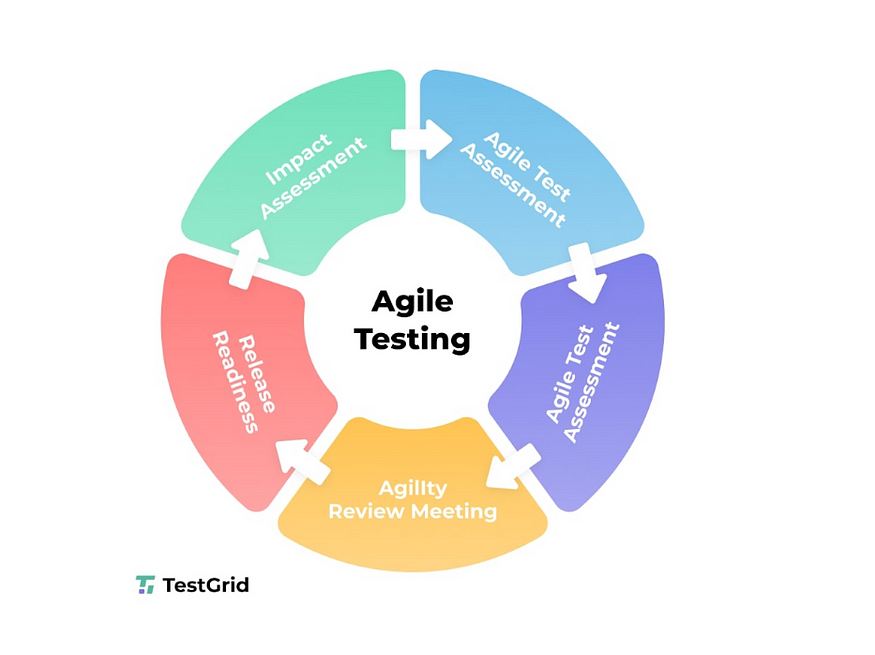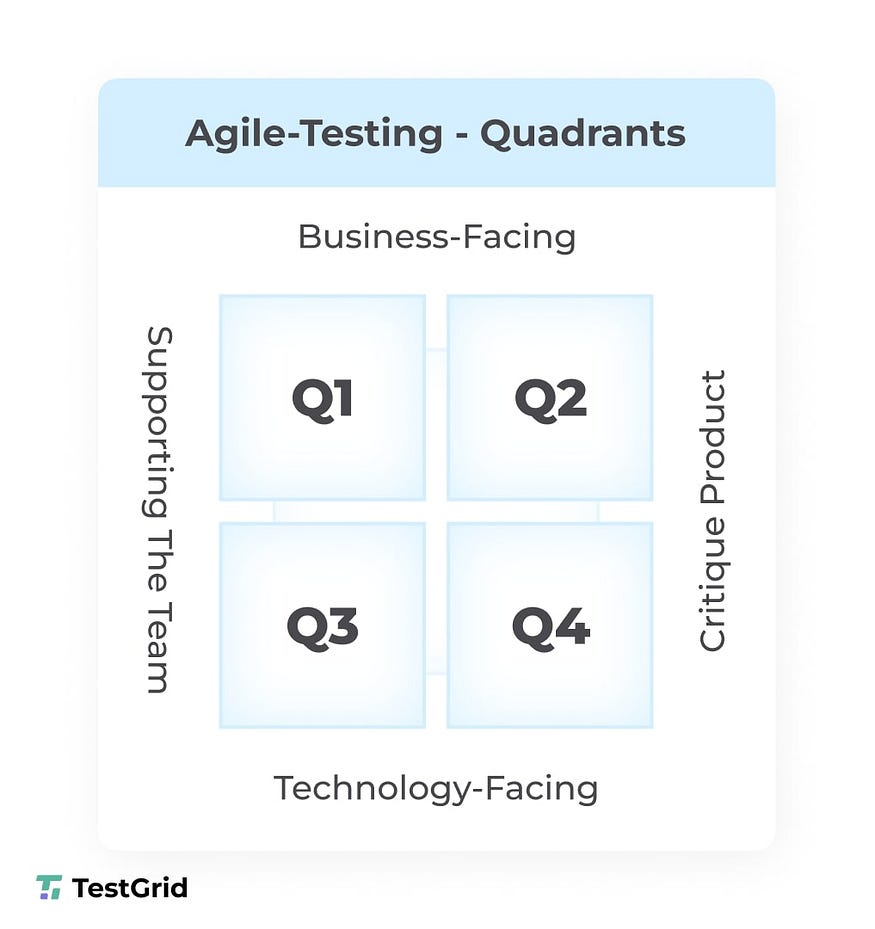Agile Testing: The Key to Faster, Higher-Quality Releases
 Emma Thomsan
Emma ThomsanIf you’ve been a part of a software development project, you know that testing often feels like a bottleneck. Just when you think everything’s ready to go, a bunch of issues get thrown in the face, and you’re back to the drawing board.
This is where Agile Testing can make a huge difference.

What is Agile Testing?
Agile Testing is a methodology that aligns with Agile Testing principles, incorporating testing throughout the lifecycle, from inception to completion, rather than deferring it to the end.
This means the product is tested as it’s coded, which allows for early bug detection, immediate feedback, and quick adjustments, resulting in smoother, faster, and higher-quality software delivery.
Research shows that 95% of organizations use Agile development methodologies; however, 82% reveal that not all teams leverage Agile practices, indicating scope for growth in enterprise Agile adoption.
While you may be aware of how test automation can shorten delivery time, there’s uncertainty about exactly where and how to integrate it. Testing is key to any kind of Agile development and to ensuring that robust applications are built and sent to market faster.
In this blog post, we’ll explore the key activities and techniques of Agile Testing and how organizations can succeed at it.
Whether you’re new to Agile or looking to refine your software development approach, get ready to gain practical insights about this Agile Testing methodology.
Main Activities in Agile Testing
In Agile practice, testing isn’t a role; it’s an activity whose main goal is to ship a more reliable and user-friendly product at scale and without any delays. It involves iterative phases that promote quality, efficiency, and customer satisfaction.
Here are six steps typically undertaken in agile software testing:

1. Collaborate with stakeholders
Product owners, developers, and business analysts collaborate to determine exactly what the new software or feature needs to look like. Backlog grooming and sprint planning sessions are also held to clarify the acceptance criteria.
2. Test planning and design
Tests based on expected behaviors using natural language are created. Other techniques, such as boundary value analysis, equivalence partitioning, and exploratory testing, help build comprehensive test scenarios.
3. Automated testing
Automated test scripts are implemented to ensure continuous testing and quick feedback. After each integration, they run into the CI/CD pipeline to ensure the codebase is stable and functional.
4. Manual testing
This form of testing validates the software’s functionality, usability, and performance. It helps uncover edge cases and potential issues, which are usually not covered by automated tests.
5. Defect management
Defects found during testing are logged and tracked using a defect tracking tool, which provides straightforward and detailed troubleshooting descriptions. To address critical problem areas faster, defects are prioritized based on severity and impact.
6. Performance, load, and user acceptance testing
Performance and load testing ensure the software can handle expected user loads and operate under stress. User Acceptance Testing (UAT) sessions involving end-users validate that the software meets their needs and expectations.
The Agile Testing quadrants
Agile Testing is known for being context-dependent. Meaning you can make decisions on what and how to test based on the specific circumstances and needs of the software development project at any given time.

Four quadrants help with this process. Each indicates which type of testing is best for a specific business situation and whether to use automated or manual testing.
Quadrant 1: Technology-facing tests that support the team
This includes two types of tests:
Unit tests, written and executed by developers to verify the code’s functionality
Component tests focus on the interaction between different software parts
This quadrant can involve a large degree of automation.
Quadrant 2: Business-facing tests that support the team
This involves conducting:
Functional tests that verify the software’s functionality against the specified requirements
Story tests that validate the implementation of user stories and ensure that the software behaves as expected
You can run prototypes and simulations to validate ideas and concepts early in development. This quadrant helps Agile teams improve business and customer value results.
Quadrant 3: Business-facing tests that critique the software
In this quadrant, tests focus on the user experience rather than just the code quality. Typically, senior QA engineers conduct exploratory and scenario-based tests, using critical thinking and intuition to determine how the end-users will respond.
They actively explore the software without predefined test cases and validate end-to-end workflows to evaluate the user interface and overall user experience based on real-world scenarios.
Quadrant 4: Technology-facing tests that critique the software
This includes four types of tests to check things like data security or software stability:
Load testing evaluates how the software handles a high volume of users or transactions.
Security testing identifies vulnerabilities and ensures the software is protected against threats.
Compatibility testing verifies the software works across different devices, browsers, and operating systems.
Performance testing ensures the software meets performance requirements, such as response time and throughput.
Importance of Agile Testing
Agile Testing has gained popularity over the last decades, especially for DevOps functions. Here’s how you can benefit from it:
1. Simplicity
Keeping the testing processes and strategies simple ensures they’re effective and maintainable. It also means you get to focus on delivering the simplest possible solution that works.
2. Reduced costs
By detecting and fixing errors early on, you can avoid spending more money on fixing bigger problems in the software later on.
3. Greater flexibility
One of the fundamental principles of Agile Testing is flexibility and adaptability to different scenarios, which enables pivoting the development process as needed. For instance, after conducting focus groups, you might realize that users don’t favor one software feature.
In response, Agile Testing equips you to quickly adjust by reprioritizing tasks, modifying or removing unpopular features, and redeploying resources to enhance other parts of the software that users find more valuable.
4. Clearer customer focus
As a developer, your primary goal is to deliver value to the customer. Agile Testing emphasizes understanding user needs and ensuring that the final product meets or exceeds their expectations.
5. Higher software quality
Agile Testing is all about testing early and often. This way, any flaws are immediately highlighted and fixed, ensuring a higher quality of the end product.
6. Quicker time-to-market
Agile Testing speeds up the development process, which means your finished product can be delivered to customers faster. This can be a big help in maintaining competitive adaptability by quickly capitalizing on new market opportunities.
Top Agile Testing Methodologies to Know
There are five main approaches to Agile Testing:
1. Scrum
Scrum is one of the most popular Agile Testing methods. It’s driven by a user story or requirement the product owner receives, which defines how features should work based on customer feedback.
This is then converted into acceptance criteria, based on which code is written and tested. At the end of each sprint, the code is tested again in a production-like environment. Scrum focuses on regular communication through daily stand-ups and sprint retrospectives.
For example, if you’re part of a Scrum team developing a new mobile app, you’d follow a structured sprint cycle, including planning, development, testing, and review phases.
During the sprint, you might focus on delivering specific user stories, conducting daily stand-up meetings to track progress, and performing sprint reviews and retrospectives to identify improvements.
2. Kanban
Kanban is a prevalent Agile Testing methodology because it is similar to the conventional waterfall method. This allows companies to transition more easily into the Agile space.
It involves detailed planning at a feature level and handing off activities among team members as each completes their duties. Regular status updates and maintaining visibility are vital to ensuring Kanban works.
For example, suppose you’re using Kanban to manage a software development project. In that case, you’d visualize your workflow on a Kanban board, with columns representing different stages like “To Do,” “In Progress,” and “Done.”
Team members will pull tasks from the “To Do” column based on their capacity and move them through the workflow. By limiting work in progress and focusing on continuous delivery, you can quickly identify bottlenecks, improve efficiency, and ensure a steady flow of completed tasks.
3. Test-driven development (TDD)
This classic Agile Testing method involves developing code against automated test units rather than requirements stated upfront. The advantage here is that there’s no risk of the code being created only to realize that the requirements were misunderstood in the first place.
Testers are involved much more from the beginning, making it more collaborative. Suppose you’re developing a new software login feature; in that case, you write a unit test specifying the expected behavior, such as validating user credentials and handling login failures.
Once the test is written, you’ll implement the minimal code needed to pass the test. After the test passes, you’d refactor the code to improve its structure and efficiency, ensuring that the functionality remains intact and the test continues to pass.
4. Behavior-driven development (BDD)
This version of TDD involves an initial requirement based on end-user behavior rather than a unit test. The behavior that the finished product must exhibit guides the developer and tester when designing the automated test.
For example, if you’re developing a search feature for a website, you’d use the Gherkin language to create scenarios that describe user behaviors. A scenario might include entering a search term, filtering results, and selecting an item from the results.
By defining these behaviors in a human-readable format, you can facilitate communication between developers, testers, and stakeholders and ensure that the feature meets user needs and functions as intended.
5. Acceptance test-driven development (ATTD)
This is similar to TTD in that tests are prepared in advance. However, the tests are end-user acceptance tests rather than technically facing unit tests. The focus is on how end users perceive the product, and thus, this form of testing requires close communication with the customer base.
For example, if you’re working on an eCommerce application, you’d collaborate with stakeholders to define acceptance tests for the checkout process. These tests might include scenarios like adding items to the cart, applying discount codes, and completing a purchase.
By writing these acceptance tests before implementing the feature, you ensure that the development aligns with business requirements and user expectations, and you can continuously validate the functionality through automated tests.
Challenges of Agile Testing
Despite the many Agile Testing best practices and benefits, there are some disadvantages that need to be kept in mind:
1. Fragmented output
Agile Testing focuses on incremental delivery by working on each software component in different cycles. However, this could sometimes mean that the output is less cohesive as a unit.
2. Harder to measure
Agile Testing doesn’t have any clear KPIs at the start. Progress is tracked on the go, making overall impact tougher to measure.
3. Limited documentation
Documentation in an Agile software development project happens with time. While the goal is to keep things moving, this often means that documentation is more scrappy. It might not be as detailed or organized, making it less useful as a resource to refer back to.
4. No clear end to a project
Since testing every aspect of a software build is rarely possible, it’s vital to set priorities in advance and outline exactly how testing will occur to avoid delays and duplication.
However, as needs evolve, you may have to keep realigning your priorities, which means there’s less clarity on when exactly the project will “end.”
5. Harder to plan resources
Given that Agile Testing, by definition, involves a flexible and iterative approach to development, the result is not always clearly defined at the start. This lack of a fixed endpoint can make it challenging to predict the resources needed for the project.
Conclusion
Agile Testing is vital for faster, high-quality software releases by integrating testing throughout the development process, ensuring early bug detection, and allowing quick adjustments. It emphasizes collaboration, automation, and flexibility, which results in more reliable products that meet user needs. Despite some challenges, Agile Testing is essential for continuous improvement, reducing costs, and speeding up time-to-market, making it a cornerstone of modern software development.
Source: This article was originally published at: https://testgrid.io/blog/agile-testing/
Subscribe to my newsletter
Read articles from Emma Thomsan directly inside your inbox. Subscribe to the newsletter, and don't miss out.
Written by
